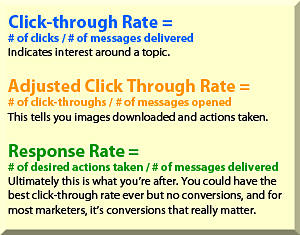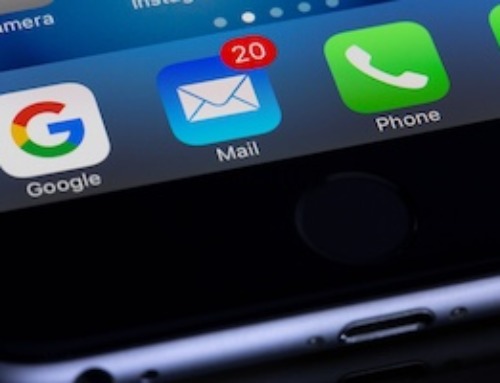 Recently a client asked us if “click-able” graphics and buttons should be avoided in his email marketing. This client worries that email click-through rates are harmed because important content in graphics are not visible. He asked if our other clients avoid images and make all buttons as text-in-tables.
Recently a client asked us if “click-able” graphics and buttons should be avoided in his email marketing. This client worries that email click-through rates are harmed because important content in graphics are not visible. He asked if our other clients avoid images and make all buttons as text-in-tables.
The big answer to his question is, of course, it depends. It depends on your audience and their expectations and desires. It depends on your brand, because some brands are built on imagery. And it depends on how well you adhere to email marketing best practices that affect your use of images in email.
Make no mistake: we people are visual creatures. Imagery has its place, and it’s a pretty high priority one. (If you think images don’t matter, please explain the escalating popularity of Pinterest!) In most cases, an email is more visually appealing when it includes an image, and that could mean higher conversion rates. However, in most cases, the image won’t be seen due to image blocking.
Let’s also be clear that we aren’t only talking about pictures. The term “images” also refers to graphics like call to action buttons or call-outs with the offer highlighted, such as a graphic that says “35% Off” or “Only 3 Days Left.” When images are blocked, not only does your recipient miss out on the possibly engaging pretty picture. He or she will miss out on the offer or deadline too, if you’re not working around the whole image blocking issue. And you’ll miss out on the opportunity for conversion.
Chances are they’re not seeing your images anyway
Lest we get too far into this discussion under false pretenses, let’s make sure this is clear from the start: images are blocked by default in most email clients, meaning many times images aren’t seen anyway, whether a picture or a graphic. If it’s an image, it’s blocked until the recipient says otherwise.
And don’t assume they will say otherwise. In one study of consumer behavior, only 55% of respondents said they turn on the images in the emails they receive. But only 16% will add a business as a safe sender—which would ensure images appear in every email from that sender. That puts the onus on the marketer to make sure recipients want to see the images in your emails and will choose “show images” consistently (although you should continue to ask to be added to the safe senders list too).
How to determine the effect of images in emails
In order to determine if images have a positive or negative effect on your click-through rate (and email ROI), and to ensure your emails are as effective as can be with or without said images, consider the following factors and best practices:
Know your audience
Before knowing the answer to the images question, you must know your audience. How many are using mobile devices and which ones? Which email clients are they using? What’s the likelihood that they have images turned off? How likely are they to turn images on? What difference can you measure between the effectiveness of emails with images and those without?
Know your brand
How crucial is imagery to your brand and your marketing? If your brand is all about the visual, say you’re a retailer selling women’s fashion, for example, images will likely be paramount to successful email marketing. If your brand is all about data security, however, imagery might not have the same impact as words.
Assume your images won’t show
Regardless of what testing teaches you about your company’s use of images in email, be prepared for blocking, always. Make sure anything important appearing as an image is reiterated as text, such as a call to action or a special offer. For example, if your email design includes a banner offering 20% off, make sure that 20% offer appears as text too, preferably bold text that stands out in the same way the banner does. If you have information that’s worth putting in an image to make it stand out, it’s worth putting in text to make sure it’s included.
Offer alternatives
Use really good, descriptive alt text. We mean really good, specific alt text that compels the recipient to show the images…or to click through even without seeing any graphic or picture!
Test, test, test
The only way to know for certain if images affect your click-through rate—whether positively or negatively—is to test. This includes testing your calls to action, because it could very well be that your problem isn’t a lack of images but rather a lack of compelling copy. This applies to your offer too. If you find images have a positive impact, then test for types of images and placement. Conduct tests for your alt text too. Always test, always tweak, always improve.
Know what really matters
If you’re wondering about the effect of images in email on click-through rates, as our client was, be sure you’re measuring what really matters so you can determine effectiveness…or lack thereof. For example, it might be your click-through rate is lower but your conversions are higher; and conversions mean more than click-through rates, because conversions mean dollars. Determine all of the metrics you’re going to use to measure the effect of images in email and the meaning of each.
Below is some input from our Director of Creative Services to help you determine what it is you’re really measuring and what really matters when considering your use of images:
Whether images in email affect your click-through rate or not, rest assured you need to plan for your email to work both ways: with images and without. Then test and see what images do or don’t do for your email ROI. As with so many things email, the answer is, “It depends.” But it’s an answer that’s possible to figure out.




